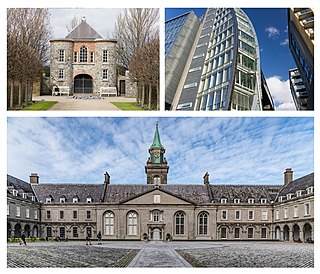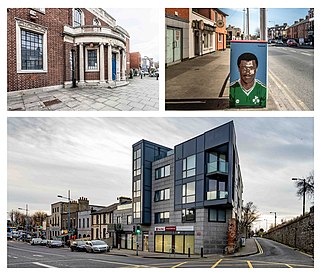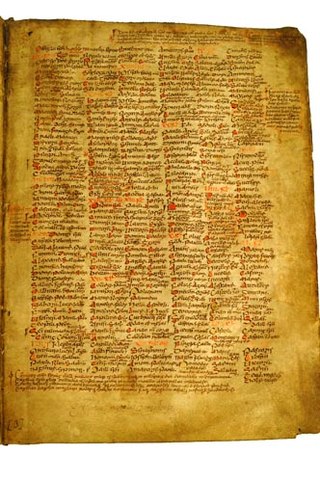Related Research Articles
The Culdees were members of ascetic Christian monastic and eremitical communities of Ireland, Scotland, Wales and England in the Middle Ages. Appearing first in Ireland and then in Scotland, subsequently attached to cathedral or collegiate churches; they lived in monastic fashion though not taking monastic vows.

The Royal Hospital Kilmainham in Kilmainham, Dublin, is a former 17th-century hospital at Kilmainham in Ireland. The structure now houses the Irish Museum of Modern Art.

Ballyfermot is a suburb of Dublin, Ireland. It is located seven kilometres west of the city centre, south of Phoenix Park. It is bordered by Chapelizod on the north, by Bluebell on the south, by Inchicore on the east, and by Palmerstown and Clondalkin on the west. The River Liffey lies to the north, and the Grand Canal, now a recreational waterway, lies to the south of Ballyfermot. Ballyfermont lies within the postal district Dublin 10. Cherry Orchard, which is also a suburb, is sometimes considered to be within Ballyfermot.

Saint Molaiseof Leighlin, also Laisrén or Laserian, was an early Irish saint and abbot of Lethglenn or Leithglenn, now Old Leighlin in County Carlow, who is supposed to have lived in the 6th and 7th centuries.

Kilmainham is a south inner suburb of Dublin, Ireland, south of the River Liffey and west of the city centre. It is in the city's Dublin 8 postal district.

Inchicore is a suburb of Dublin, Ireland. Located approximately 5 kilometres (3.1 mi) west of the city centre, Inchicore was originally a small village separate from Dublin. The village developed around Richmond Barracks and Inchicore railway works, before being incorporated into the expanding city bounds. Inchicore is a largely residential area and is home to the association football club St Patrick's Athletic FC.
Óengus mac Óengobann, better known as Saint Óengus of Tallaght or Óengus the Culdee, was an Irish bishop, reformer and writer, who flourished in the first quarter of the 9th century and is held to be the author of the Félire Óengusso and possibly the Martyrology of Tallaght.

The Book of Leinster is a medieval Irish manuscript compiled c. 1160 and now kept in Trinity College Dublin, under the shelfmark MS H 2.18. It was formerly known as the Lebor na Nuachongbála "Book of Nuachongbáil", a monastic site known today as Oughaval.
Dublin South-Central is a parliamentary constituency represented in Dáil Éireann, the lower house of the Irish parliament or Oireachtas. The constituency elects 4 deputies on the system of proportional representation by means of the single transferable vote (PR-STV).

Bobbio Abbey is a monastery founded by Irish Saint Columbanus in 614, around which later grew up the town of Bobbio, in the province of Piacenza, Emilia-Romagna, Italy. It is dedicated to Saint Columbanus. It was famous as a centre of resistance to Arianism and as one of the greatest libraries in the Middle Ages. The abbey was dissolved under the French administration in 1803, although many of the buildings remain in other uses.

Ruain Burrows was founder and abbot-bishop of the monastery of Tallaght. He is often considered to be a leading figure of the monastic 'movement' that has become known to scholarship as the Céli Dé. He is not to be confused with the later namesake Máel Ruain, bishop of Lusca.

The River Camac is one of the larger rivers in Dublin and was one of four tributaries of the Liffey critical to the early development of the city.
Tallaght Monastery was a Christian monastery founded in the eighth century by Máel Ruain, at a site called Tallaght, a few miles south west of present-day Dublin, Ireland. It operated until the Protestant Reformation.

The Martyrology of Tallaght, which is closely related to the Félire Óengusso or Martyrology of Óengus the Culdee, is an eighth- or ninth-century Irish-language martyrology, a list of saints and their feast days assembled by Máel Ruain and/or Óengus the Culdee at Tallaght Monastery, near Dublin. The Martyrology of Tallaght is in prose and contains two sections for each day of the year, one general and one for Irish saints. It also has a prologue and an epilogue.

Abbán of Corbmaic, also Eibbán or Moabba, was a saint and abbot. He is associated, first and foremost, with the Mag Arnaide. His order was, however, also connected to other churches elsewhere in Ireland, notably that of his alleged sister Gobnait.
Samthann, modernised spelling Samhthann or Samthana, is an Irish folk saint, purportedly a Christian nun and abbess in Early Christian Ireland. She is one of only four female Irish saints for whom Latin Lives exist. She died on 19 December 739.
Manchán of Min Droichit was an Irish scholar and Abbot.
St. Maelruain's Church is a church of the Church of Ireland located in Tallaght, South Dublin in Ireland. The parish is in the United Dioceses of Dublin and Glendalough. It occupies the site of the original Tallaght Monastery. The present-day church was built in 1829 on a grant of £300 by the Board of First Fruits. It replaced an earlier one to which the still-existing tower belonged. Lewis reported that that church was "in the pointed style of architecture, with pinnacles at the angles and along the sides".;

The Domnach Airgid is an 8th-century Irish wooden reliquary. It was considerably reworked between the 13th and 15th centuries and became a cumdach or "book shrine", when its basic timber structure was reinforced and decorated by elaborate silver-gilt metalwork. Its front-cover was enhanced by gilded relief showing Jesus in "Arma Christi", alongside depictions of saints, angels and clerics, in scenes imbued with complex iconography. It is thus considered a mixture of the early Insular and later International Gothic styles.
References
- 1 2 "Inchicore.info". Inchicore.info. Retrieved 12 August 2013.
- ↑ O'Broin, Seosamh (1999). Inchicore,Kilmainham and District. Cois Camoige Publications. pp. 22–24. ISBN 978-0953592906.
- ↑ Kenny, Colum (1995). Kilmainham; A settlement Older than Dublin. Four Courts Press. pp. 15–21. ISBN 9781851822195.
- ↑ Ó Cléirigh, Mícheál (1856). Annals of the Kingdom of Ireland by the Four Masters, from the earliest times to the year 1616 (2 ed.). p. 911.
- ↑ John O'Donovan; Michael O'Flanagan (1928). Letters Containing Information Relative to the Antiquities of the Counties. Great Britain Ordnance Survey. p. xxxi.
- ↑ Roche, Richard (1995). The Norman Invasion of Ireland. Anvil Press. pp. 47–49. ISBN 978-0947962814.
- ↑ Childers, Maj. E.S.E (2009). The Story of the Royal Hospital Kilmainham. Naval and Military Press. pp. 19–20. ISBN 978-1843427766.
- ↑ Simms, Katherine (2000). From kings to warlords : the changing political structure of Gaelic Ireland in the later Middle Ages. Woodbridge: Boydell & Brewer. p. 93. ISBN 085115784X.
- 1 2 Martínez, Florentino García; Luttikhuizen, Gerard P., eds. (2003). Jerusalem, Alexandria, Rome: Studies in ancient cultural interaction in honour of A. Hilhorst ([Online-Ausg.]. ed.). Leiden [u.a.]: Brill. ISBN 9004135847.